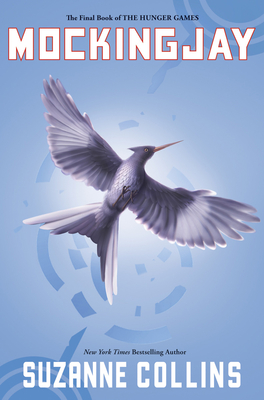Mockingjay
Suzanne Collins

[This is a review for all three of the books in the trilogy.]
Elise convinced me to read these books, and I’m glad she did!
I read “The Hunger Games” itself in one day, and though I didn’t finish the other two quite that fast, I finished each of them with a multi-hour can’t-put-it-down reading session. That alone is good enough to merit them five stars. For what they are, these books are nearly perfect.
Reading these books, I found myself thinking a lot of three other books, two of which I would consider positive comparisons and one negative.
The negative comparison is “Atlas Shrugged.” There is a lot that separates these two books (including the fact that I loved THG but disliked AS), but also a surprising amount that I found similar. They share a certain lack of subtlety and flair for the grandiose gesture. In AS, for example, the scene of John Galt’s torture, or the fact that people are so often “screaming” at each other. In THG, the extravagantly violent or unsettling obstacles in the arena. In part I think this is the case in THG because it is young adult literature, but on the other hand, I would contrast it with the restraint and subtlety of “Ender’s Game” (oops, just gave away one of my comparison books). I also think it may be somewhat intentional on the part of Collins, to call to the ever-present touchstone of the books, reality TV. Now, I don’t necessarily think this is a bad thing–certainly it was not among my major gripes with AS–just an observation. Related to this, I think, is a fairly stable clarity about who is good and who is evil in the books (something that Ayn Rand really bangs you over the head with). There are a few times in THG where someone takes a “surprising” action, but generally these have been broadly hinted at in advance. Both books evince a strong distrust of government, though from very different angles–AS obviously from a pro-free-market angle, but THG from a sort of communitarian self-help angle, the latter of which I find much more palatable. Nonetheless, in each book, the government and those associated with it are portrayed as soft, selfish, and venal.
OK, as I already gave away, the next comparison book in my mind was “Ender’s Game” (which I’ve now convinced Elise to read). It’s been over a decade since I read it, so my memory isn’t too sharp on specifics. But in general I think Katniss and Ender are very similar characters. Both are thrust from relatively circumscribed worlds into large-scale roles of responsibility; both are beset by feelings that they are pawns of larger forces (which they are); both are made to play “games” with decidedly real elements. I know Ender Wiggin was a formative hero for many adolescent boys (including myself), and I’m glad for girls to have Katniss Everdeen.
The last comparison book in my mind was “Watership Down,” also a book that is ostensibly for children but deals with fairly serious subject matter. This comparison only really came to me in “Mockingjay,” when Katniss travels to District 13. 13 is a dead ringer for Efrafa, Coin for Woundwort. The resemblance is so strong that I have to think Collins was conscious of it. 13 is literally an underground warren; its inhabitants are forced to stick to a centrally-determined schedule; it is ruthlessly regimented in the name of survival; etc. After I made this connection, I also began to think of the Capitol as Cowslip’s warren–a place where residents are well-fed and create entertainments for themselves that are inscrutable to “normal” outsiders; where their well-being is maintained only by the offering of human (rabbit) sacrifices. There are even “Strawberry"s who join the rebels, in the form of Octavia, Venia, and Flavius. District 12 is Sandleford, the refugees from 12 are Hazel’s warren, and the reborn 12 is Watership Down. Aside from all of these analogous elements, I see both books as expressing respect for a set of “natural” values, including closeness to the earth, communal self-sufficiency, and a skepticism that complete security is possible, or even desirable.